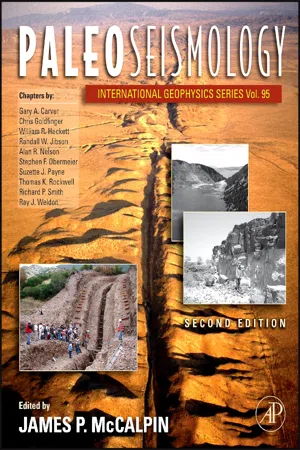
- 629 pages
- English
- ePUB (mobile friendly)
- Available on iOS & Android
Paleoseismology
About this book
Paleoseismology has become an important component of seismic risk analysis, which is mandated for nuclear power plants, dams, waste repositories, and other critical structures. This book is the first in the English language to be devoted solely to paleoseismology. It summarizes the development of the field from the 1960s to the present, encompassing material that is currently widely dispersed in journal articles.- Includes a comprehensive review of the techniques currently used in paleoseismology- Emphasizes practical methods of data collection and field studies- Covers interpretation of field data based on current theory concerning fault segmentation and recurrence cycles- Contains more than 170 line drawings and 50 photographs of paleoseismic phenomena
Frequently asked questions
- Essential is ideal for learners and professionals who enjoy exploring a wide range of subjects. Access the Essential Library with 800,000+ trusted titles and best-sellers across business, personal growth, and the humanities. Includes unlimited reading time and Standard Read Aloud voice.
- Complete: Perfect for advanced learners and researchers needing full, unrestricted access. Unlock 1.4M+ books across hundreds of subjects, including academic and specialized titles. The Complete Plan also includes advanced features like Premium Read Aloud and Research Assistant.
Please note we cannot support devices running on iOS 13 and Android 7 or earlier. Learn more about using the app.
Information
Earthquake Magnitude Scales
James P. McCalpin (email: [email protected])
 |
| Figure A.1.1 Graph showing the relationship of various magnitudes to moment magnitude (Mw). Relation for mbLg is from Atkinson and Boore (1987). For Ms and ML the relations come from fitting a quadratic to the data compiled by Ekström (1987) and Hanks and Boore (1984), respectively. From Boore and Joyner (1994); reprinted with permission of the Applied Technology Council. |
Radiocarbon Sampling Techniques
James P. McCalpin (email: [email protected])
Table of contents
- Cover Image
- Table of Contents
- Preface to the Second Edition
- Earthquake Magnitude Scales
- Radiocarbon Sampling Techniques
- Field Evaluation of Liquefaction Susceptibility of Soils with High Fines Content
- Chapter 1 Introduction to Paleoseismology
- Chapter 2A Field Techniques in Paleoseismology—Terrestrial Environments
- Chapter 2B Sub‐Aqueous Paleoseismology
- Chapter 3 Paleoseismology in Extensional Tectonic Environments
- Chapter 4 Paleoseismology of Volcanic Environments
- Chapter 5 Paleoseismology of Compressional Tectonic Environments
- Chapter 6 Paleoseismology of Strike‐Slip Tectonic Environments
- Chapter 7 Using Liquefaction‐Induced and Other Soft‐Sediment Features for Paleoseismic Analysis
- Chapter 8 Using Landslides for Paleoseismic Analysis
- Chapter 9 Application of Paleoseismic Data to Seismic Hazard Assessment and Neotectonic Research
- References